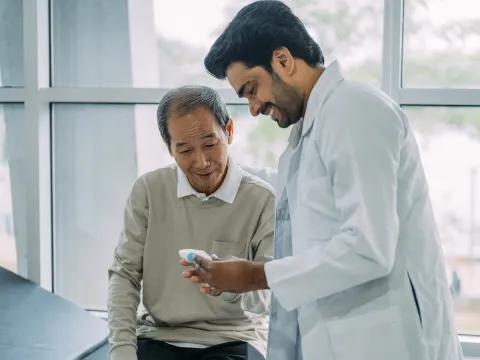- AdventHealth

Choose the health content that’s right for you, and get it delivered right in your inbox.
Whether you live in the sunny state of Florida or face long, grey winters in Illinois, vitamin D deficiency is more common than you think. In fact, about 42% of Americans are deficient in vitamin D. If you’re looking for more information on the causes, symptoms and treatments for vitamin D deficiency, you’ve come to the right place.
Vitamin D 101
Vitamin D is one of the many important vitamins we need to keep our bodies healthy. It helps keep bones strong by absorbing calcium, aids in your mood and works with your parathyroid glands to regulate your blood and vital organs.
Vitamin D is unique because your skin produces it by using sunlight, which is why it is often called “the sunshine vitamin.”
Symptoms and Causes of Vitamin D Deficiency
Vitamin D deficiency means you do not have enough vitamin D in your body. There is no single cause for the deficiency, but studies have found that fair-skinned individuals and those who are younger, such as children or teenagers, convert sunshine into vitamin D more efficiently than those who are darker-skinned or over the age of 50. Other causes of vitamin D deficiency include:
- Having a chronic kidney or liver disease
- Having hyperparathyroidism
- Living far from the equator or in regions with little to no sunlight
- Not eating fish or dairy
- Staying or working indoors for long periods
- Using medications that affect vitamin D metabolisms, such as certain laxatives or steroids
A deficiency can impact your body in many ways, such as:
- Bone pain
- Cancer
- Cognitive impairment
- Fatigue
- Increased risk of cardiovascular disease
- Mood changes, like anxiety or depression
- Muscle weakness or cramps
- Severe asthma in children
Children who are vitamin D deficient can also have severe asthma, incorrect growth patterns and deformities in joints.
How Is Vitamin D Deficiency Diagnosed?
According to the National Library of Medicine, the best way to diagnose vitamin D deficiency is a blood test that measures the concentration of 25-hydroxyvitamin D. However, it isn’t common for health care providers to order this blood test, but you can request it from your provider.
If you show severe signs of vitamin D deficiency, your health care provider may request a screening. The optimal vitamin D level is at least 30 nanograms per milliliter (ng/ml).
Treatment Options
Eating more foods containing vitamin D and getting extra sunlight throughout your day can help gradually increase your vitamin D production and help minimize your symptoms. If you suffer from a great deficiency, your doctor may recommend taking vitamin D supplements.
Vitamin D comes in two forms: D2 and D3. Vitamin D2 comes from plants, while vitamin D3 comes from animals. You will need a prescription to get vitamin D2, but vitamin D3 is available over-the-counter. Talk to your doctor to determine if you need a vitamin supplement, how much to take and which one will work best for you.
How to Increase Vitamin D Levels
The recommended dietary allowance (RDA) of vitamin D for adults 19 to 70 years old is 600 international units (IU) a day. However, for those severely deficient, you may need a vitamin D prescription from your health care provider in doses up to 50,000 IU.
For those who are vitamin D deficient, you can increase your levels in many ways. To do so, we recommend taking vitamin D supplements and magnesium and pursuing safe sun exposure. There are also plenty of foods naturally high in vitamin D, including:
- Beef liver
- Egg yolk
- Fatty fish, like salmon, tuna, mackerel and rainbow trout
- Fortified milk and juices
- Mushrooms
- Yogurt
It’s important to talk to your primary care provider before increasing your vitamin D levels to ensure it’s right for your health.
How Long Does It Take to Restore Vitamin D Levels?
How long it takes to recover vitamin D levels depends on several factors, including your age, overall health and how deficient you are. However, restoring your vitamin D levels generally takes 6 to 8 weeks. Once restored, your doctor may recommend you stay on supplements for a few weeks to maintain steady levels.
Helping You Feel Whole Again
If you are experiencing any vitamin D deficiency symptoms, we can help. Schedule a lab appointment today to find out if you lack vitamin D, and find a primary care provider to find the best course of action to increase your vitamin D production. With onsite labs with quick results, we’ll help you feel whole in no time.



